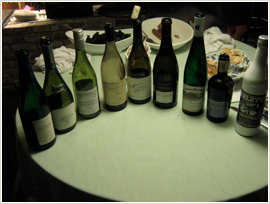By Kareasa Wilkins
The world of wine is a many splendored thing, but it can be daunting because there is just so damn much to learn about it. Grape varietals, regions, producers, interpreting the language of wine bottles—all of these things can be intimidating to the novice wine drinker. Yet if you’ve established the fact that you enjoy consuming wine and you’d like to learn more about it, one of the best ways to improve your wine knowledge and have a fun time doing it is by hosting a wine tasting party. Wine tasting parties are also great for people who already know quite a bit about wine as there is always something new to learn by wine tasting.
Before you begin, you should establish a few things. First decide how many people to invite, and only invite people who are serious about learning more about wine. Wine tasting parties can all to easily turn into drunken ragers if the people involved are focused more on drinking than on educating themselves. It’s best to keep the group relatively small, though that depends on how much space you have. You should be able to provide a table space that is free from any distracting noises or smells, and ideally you should use a white tablecloth or white paper background in order to see the wines clearly. Also, be sure to provide a spit/dump bucket. As much fun as it is to get a little tipsy from wine, the professional way of tasting is to sip and spit. This allows you to have a clear head to analyze the wines and helps ensure that you won’t have people crashed out on your couch after the party.
Unless you have a huge selection of glassware, the best thing to do is have your guests bring their own glassware—one glass for each wine you are going to taste is ideal, since side-by-side tastings are an excellent way of distinguishing the different nuances between wines. You also need to determine how much wine you plan to taste, and who will be providing it. You can provide all of the wine yourself and trade off by having different people host the parties each time you meet. Alternatively, you can buy all of the wine and collect money from your guests, or you can have each person bring a wine to the party. Before the party, you should come up with a method of analyzing the wines that will be served. In most recognized wine societies, such as the Wine and Spirits Education Trust and the International Sommelier’s Guild, the following items are assessed in a wine tasting:
Appearance: (including clarity, intensity, color, rim vs. core)
Nose: (including condition, intensity, development, fruit character)
Palate: (including sweetness, acidity, tannin, fruit intensity, fruit character, alcohol, length)
Conclusions: (including quality, maturity, price range, region)
You may also come up with a rating of the quality of the wine or how well you like it.
Once you’ve figured out your method of analyzing the wines, the fun part is deciding what type of tasting party to host. There are numerous types of tastings you can do, but here are a few suggestions:
Varietal Focus: This is one of the best ways to get to know the character of a particular grape variety and the subtle differences between the regions in which the grape is grown. For this theme, first choose a varietal, such as Pinot Noir.
Ask each person to bring a Pinot Noir from a different region: ie, Carneros, Santa Lucia Highlands, Willamette Valley, Burgundy, New Zealand. Pour the wines side-by-side, and assess the similarities and differences between the wines. Alternatively, you could do a varietal tasting of Pinots from the same region, but different producers.
Country/Region Focus: For people who are just beginning to learn about the world of wine, focusing on a country, such as France or Italy, or a region, such as Bordeaux or Piedmont, is a great way of expanding your wine knowledge. This is the perfect opportunity to do research—look at maps, provide a handout for your guests, or assign a different region of one country to each guest and have them research and talk about their assigned regions.
Does Price Really Matter?: This is a good sub-theme of a varietal focus party. Choose a varietal, such as Cabernet, and buy one wine in the $10-under category, one in the $10-$20 range, one in the $20-30 range, and one in the $40-and over category. Blind taste the wines side-by-side and see if price really makes a difference.
Guess the Varietal: Buy different varietal wines and blind taste them side-by-side to see if you can guess which is which. This is a great party theme if you have a more experienced palate. If you are new to wine tasting, do research on the typical flavor profiles of the varietals that you are serving. Discuss these before tasting, then see if the wines conform to their typical tasting profiles.
Old World vs. New World: Another sub-category of the varietal focus. Pick a grape varietal, such as Grenache, and find examples from the New World (ie. The U.S., Chile, Australia), then find examples from the Old World (France—the Rhone Valley, Spain, Sardinia) and assess the similarities and differences.
Vertical Tasting: A vertical tasting is a tasting of the same wine from different vintages. If you are lucky enough to have access to multiple vintages of the same wine, this is a great way to taste the difference of vintage. For example, pour a Ridge Montebello 2001, 2002, 2003, and 2004, and look for the differences and how the wine changes with time.
But the fun doesn’t stop here…tasting parties give you the opportunity to be creative. Just about any tasting theme you can think of can be successful and educational, so call your friends and bring out the corkscrew!

